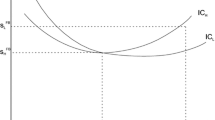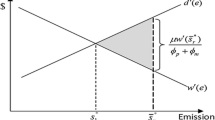Abstract
In an environmental setting, we examine different forms of harmonization based on either strict liability or negligence assuming the firm is judgment proof. When there is competition in standard setting then negligence dominates strict liability if there is upward pressure on standards. This upward pressure on standards arises as jurisdictions attempt to raise negligence standards. The desire to raise standards is affected by the degree of judgment proofness.
Similar content being viewed by others
References
Boyd, J. (2001). “Financial Responsibility for Environmental Obligations: An Analysis of Environmental Bonding and Assurance Rules.” Working Paper, www.cserge.ucl.ac.uk/Boyd.pdf.
Boyd, J. & Ingberman, D. (1997). “The Search for Deep Pockets: Is ‘Extended Liability’ Expensive Liability?” Journal of Law, Economics and Organization. 13(1), 232–258.
Boyer, M. & Laffont, J.-J. (1997). “Environmental Risks and Bank Liability.” European Economic Review. 41, 1427–1459.
Brander, J. & Spencer, B. (1985). “Export Subsidies and Market Share Rivalry.” Journal of International Economics. 18, 83–100.
Demougin, D. & Fluet, C. (1999). “A Further Justification for the Negligence Rule.” International Review of Law and Economics. 19, 33–45.
European Commission. (2000). White Paper on Environmental Liability. European Communities, Luxembourg.
Feess, E. (1999). “Lender Liability for Environmental Harm: An Argument Against Negligence Based Rules.” European Journal of Law and Economics. 8, 231–250.
Feess, E. & Hege, U. (1999). “Safety Monitoring, Capital Structure and 'Financial Responsibility'.” Unpublished manuscript.
Feess, E. & Hege, U. (2000). “Environmental Harm and Financial Responsibility.” The Geneva Papers on Risk and Insurance. 25(2), 220–234.
Greaker, M. (2003). “Strategic Environmental Policy When the Governments are Threatened by Relocation.” Resource and Energy Economics. 25, 141–154.
Heyes, A. (1996). “Lender Penalty for Environmental Damage and the Equilibrium Cost of Capital.” Economica. 63, 311–323.
Hoel, M. (1997). “Environmental Policy with Endogenous Plant Locations.” Scandinavian Journal of Economics. 99(2), 241–259.
Jost, P.-J. (1996) “Limited Liability and the Requirement to Purchase Insurance.” International Review of Law and Economics. 16, 259–276.
Kornhauser, L. & Revesz, R. (1990). “Apportioning Damages Among Potentially Insolvent Actors.” Journal of Legal Studies. 19, 617–651.
Lewis, T. & Sappington, D. (1999). “Using Decoupling and Deep Pockets to Mitigate Judgment-Proof Problems.” International Review of Law and Economics. 19, 275–293.
Markusen, J., Morey, E. & Olewiler, N. (1995). “Competition in Regional Environmental Policies When Plant Locations are Endogenous.” Journal of Public Economics. 56, 55–77.
Oates, W. (1998). “Environmental Policy in the European Community: Harmonization or National Standards?” Empirica. 25, 1–13.
Pitchford, R. (1995). “How Liable Should the Lender Be? The Case of Judgment-Proof Firms and Environmental Risk.” American Economic Review. 1171-1186.
Rauscher, M. (1991). “National Environmental Policies and the Effects of Economic Integration.” European Journal of Political Economy. 7, 313–329.
Rauscher, M. (1995). “Environmental Regulation and the Location of Polluting Industries.” International Tax and Public Finance. 2, 229–244.
Shavell, S. (1986). “The Judgment Proof Problem.” International Review of Law and Economics. 6, 45–58.
Ulph, A. (1996). “Environmental Policy and International Trade When Governments and Producers Act Strategically.” Journal of Environmental Economics and Management. 30, 265–281.
Ulph, A. (2000). “Harmonization and Optimal Environmental Policy in a Federal System with Asymmetric Information.” Journal of Environmental Economics and Management. 39, 224–241.
van Egteren, H. & Smith, R. T. (2001). “International Harmonisation of Environmental Law: Theory with Application to the European Union.” In Anthony Heyes (ed.), Law and Economics of the Environment. Edward Elgar, Cheltenham, UK, pp. 280–301.
van Egteren, H. & Smith, R. T. (2002). “Environmental Regulations Under Simple Negligence or Strict Liability.” Environmental and Resource Economics. 21, 369–396.
Wellisch, D. (1995). “Locational Choice of Firms and Decentralized Environmental Policy with Various Instruments.” Journal of Urban Economics. 37, 290–310.
Wiggins, S. & Ringleb, A. (1990). “Liability and Large-Scale, Long-Term Hazards.” Journal of Political Economy. 98, 574–595.
Xing, Y. & Kolstad, C. (2002). “Do Lax Environmental Regulations Attract Foreign Investment?” Environmental and Resource Economics. 21, 1–22.
Author information
Authors and Affiliations
Rights and permissions
About this article
Cite this article
van Egteren, H., Smith, R.T. & McAfee, D. Harmonization of Environmental Regulations When Firms are Judgment Proof. European Journal of Law and Economics 17, 139–164 (2004). https://doi.org/10.1023/B:EJLE.0000014573.80325.2c
Issue Date:
DOI: https://doi.org/10.1023/B:EJLE.0000014573.80325.2c




